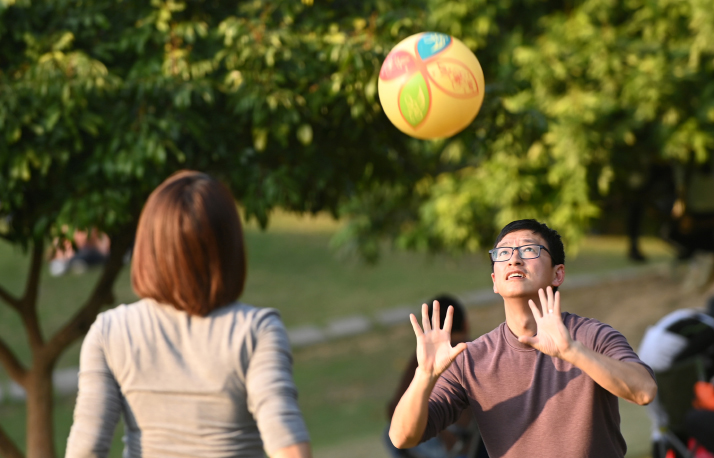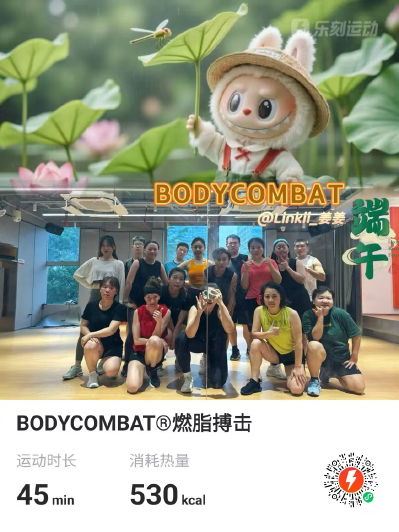| China |
| From dumplings to dumbbells, young Chinese are pumping up their pursuit of physical health | |
|
|
 People play volleyball in a lakeside park in Nanning, Guangxi Zhuang Autonomous Region, on March 2 (XINHUA)
A Beijing park at sunrise. Twenty-somethings in neon leggings let the pickleballs fly, while others sip matcha protein shakes and compare sleep-tracking stats. Welcome to China's new health renaissance. Driven by social media savvy and a hunger for balance, young Chinese are ditching old stereotypes. They're steaming their buns and sculpting their glutes, swapping late-night hotpot for qingshi (literally "light food"), and turning sweat sessions into shareable content. Even the humble sweatband is staging a comeback—because why torch calories without a touch of retro flair? But this isn't just about aesthetics. With updated dietary guidelines coming in straight from the top, the establishment of weight loss clinics nationwide and an overall appetite for improving quality of life, China's youth are investing in long-term health—one mindful bite and explosive burpee at a time. Time to stretch those hamstrings—we've got a lot of ground to cover. The BIG picture China's relationship with weight is shifting fast. The BMI scale (that's body mass index, a simple calculation using a person's height and weight to estimate body fat and categorize weight status) in China classifies anything over 24 (25 in the U.S.) as overweight and beyond 28 (30 in the U.S.) as obese. Though for children and adolescents there may be other factors that come into play, the BMI remains a good indicator. And here's the wake-up call: According to the National Health Commission (NHC), 51.2 percent of Chinese adults (some 400 million people) now fall into these categories, with projections suggesting that number could skyrocket to a whopping 70 percent (circa 630 million people) by 2030 if nothing changes. The proportion of overweight men alone almost doubled in a single generation and the proportion of obese people is rising even faster than the overweight population. The health toll is clear: Obese individuals face two to three times greater risks of weight-related complications, including diabetes, hypertension and cardiovascular issues—and that's just three items on a long list. Even more alarming: Childhood obesity has exploded. According to a report published by the NHC in 2020, one in five Chinese youth aged 6-17 was overweight or obese, up from just one in 20 in 1995. China's kids are caught in a perfect storm: endless homework, ubiquitous smartphones and a cultural legacy that often still equates "more food" with "better health." Society has taken notice—and is trying to take action. On China's super popular lifestyle and e-commerce app RedNote, the hashtag "the quickest and most effective way for children to lose weight" had raked in 1.3 million notes as of June 4. Hashtag, "the quickest and most effective way to lose weight" had raked in 5.8 million, with many netizens posting their food diaries and diet plans—sometimes leaning toward the dangerous (think: "how to lose 11 kg in seven days" or "buy this appetite-suppressing drug"), as well as more wholesome ways that involve infusing your water or tea with some traditional Chinese medicine (TCM)—we'll circle back to that. While millions scroll for weight-loss hacks on RedNote, China's policymakers are taking the fight against obesity, a budding public health emergency, from feeds to facts on the ground. This isn't just trending—it's transforming. Science, structure and serious resources "If you don't lose weight, even the government is side-eyeing you," joked one netizen three months ago. "The country says it's time to slim down—guess I don't have a choice," quipped another. "Do I get a bonus for every dumpling I skip?" a third asked. The memes practically wrote themselves when the NHC dropped its latest policy at a press conference on March 9, where NHC chief Lei Haichao announced plans to establish more weight loss clinics at medical and health facilities nationwide, aiming to help people shed pounds safely and transition to healthier lifestyles. The announcement sparked animated debate across social media like microblogging platform Weibo and RedNote. At its core, it is an intensification of the three-year Weight Management campaign (2024-26), launched by the commission last August, which pushes for a fitter, more nutritious approach to daily life to prevent weight-related illnesses. The message is clear: The state is bringing in the big guns, i.e., science, structure and serious resources. Within weeks of Lei's March "micdrop," hospitals across the country began rolling out what netizens have dubbed "obesity ERs"—multidisciplinary clinics where dietitians, fitness experts and AI coaches collaborate on personalized slim-down strategies. On Douyin, the Chinese version of TikTok, weight-loss journeys have since become the new unboxing videos, with users documenting everything from meal prep hacks to clinic consultations—their content proving both entertaining and educational. But the ripple effects of China's national wellness push are already extending far beyond clinical settings, as sectors ranging from the corporate boardroom to tourism seek to support healthier lifestyles. Some companies are incentivizing employees to shed those excess pounds. Sichuan Province, in southwest China, aims to bring workplace exercise programs to 50 percent of its government agencies and enterprises within three years. Meanwhile, newspaper China Business Herald in late March ran an article about a Shenzhen-based tech firm and its Lose Weight, Make Money challenge, offering employees cash rewards for sustainable weight loss—100 yuan ($14) per 0.5 kg lost (up to 5 kg), and a boosted 300 yuan ($42) per 0.5 kg beyond that. And from the corner offices, the get-fit revolution is taking to new heights. People's Daily Online reported in late March that provincial culture and tourism authorities across China are reimagining sightseeing, swapping passive photo ops for active adventures. Scenic destinations now offer hiking-focused itineraries that pair breathtaking views with calorie-burning climbs. Take Shanxi Province: Its culture and tourism department has been actively promoting walking-friendly routes through historic sites and natural wonders, turning cultural exploration into an energizing workout. Of course, as any fitness expert will tell you, exercise is only part of the equation. The real secret? Diet.  Feast your eyes on these June RedNote posts: (clockwise) some of the lightest and brightest qingshi to order in Beijing, how the Chinese Government lends people a helping hand in fighting the flab with policy and flavor, salads so crisp they'll convert even staunch carb-lovers, and tea infused with traditional Chinese medicine ingredients that slim and soothe. Because modern wellness just tastes better with 5,000 years of backup
You are what you eat The age-old adage holds true: Getting fit is 20 percent about breaking a sweat and 80 percent about what's on your plate. Or in your cup. Because those liquid calories can definitely sneak up on you. Take China's beloved milk tea, packing up to 300 calories per sugary, creamy serving. But change is brewing in this area. As health consciousness predates recent government initiatives, tea chains are already adapting. Popular milk tea brand CHAGEE relaunched its Spring Mountain Awakens Longjing tea in March with a "less burdensome for the body to absorb" message, according to Dao Insights, a website publishing high-value case studies from China. Bubble tea chain Naixue, with a penchant for premium quality, went one step further, opening the Green by Naixue café in Shenzhen—swapping boba for superfood bowls, as per the Dao Insights article, published on March 14. And then there are those milk tea lovers who swear by infusing their favorite brew with some TCM ingredients—a little tapioca here, some dried tangerine peel there—to achieve digestive harmony. Just FYI: TCM recommends consuming bitter, sour and pungent foods for weight loss, while avoiding sweet, salty and fatty foods that can lead to weight gain. China's national nutrition and health steering committee must have taken a leaf out of the TCM manuscript when it updated its dietary guidelines in late May, amid the growing concern about the rising obesity rates. The bottom line: Eat your fresh veggies, get those fruit slices in, whole grains are a go and aquatic products are your regimen's BFFs. Over the past two years, young consumers have already quietly championed a nutrition-first mindset, opting for fresh meals over fast food. One of the standout trends in this health-conscious movement is qingshi, which first appeared in China in the early 2010s, when people were set on honing and toning their appearance following the country's economic takeoff. This concept emphasizes consuming unprocessed, minimally refined foods, focusing on fresh fruits, vegetables, lean proteins and whole grains. Leading food delivery platforms like Meituan and Ele.me now burst with qingshi options, though this Western European diner has noted the occasional creative interpretation—Thousand Island dressing, really? Dear restaurants: We'll get there. The trend gained Olympic-sized momentum last summer during the Paris Games, with social media buzzing over athletes' "light food diets." While looking like a swimmer requires more than menu changes, China's wellness wave shows no signs of cresting—proving that lasting health starts at the table, not just the treadmill. While guidelines and healthy eating trends clean up diets, China's fitness craze is hitting its stride—literally.  Post-class glow? Drenched, gymgoers, including this author boasting a red top and matching face, pose for a group pic after a Body Combat fitness class in Beijing on June 1 (SCREENSHOT)
Class is in session "Are you feeling the suan?!" This author was. Suan means "sour," but is basically the Chinese version of "feel the burn." Fitting, given that the "burn" is produced by lactic acid (ru suan). Midway through a packed Body Combat class at a Lefit outlet in central Beijing's Dongzhimen area in Chaoyang District—where combat-inspired cardio meets a nightclub vibe (lights and music included)—our instructor Linkii screams over the pulsing beats. For the uninitiated: Body Combat blends martial arts moves (kicks, punches and knees) with high-energy choreography, all set to heart-pumping remixes. Think Zumba meets self-defense class. Lefit and gyms like it have been game changers in China's fitness scene over the past five to 10 years, some boasting up to 1,000 locations to get your workout in, be it using equipment or taking one of their extremely popular fitness classes, nationwide—at very affordable prices. Han Wei, the company's founder and a former tech whiz at e-commerce giant Alibaba, once stated in an interview he "saw fitness not just as a business but as a right for every Chinese citizen." So here we are, over 20 drenched devotees punching the air in unison, sneakers squeaking against the floor. This isn't just exercise; it's collective catharsis with a side of Capoeira-style lunges. "We turn office stress into endorphins," Linkii told Beijing Review when asked why these classes are so popular. "The explosive nature of these actions, like punching and kicking, can really release negative emotions accumulated in daily life, as many young people are currently under a lot of pressure most of the day, boosting confidence and motivation." Mental balance: check. But what about that balance on the scales? "For those looking to lose weight, this also brings greater calorie expenditure. Additionally, the program is highly inclusive; even if you are a beginner in fitness, you can participate, as instructors provide options for both beginner and advanced levels," she added. The obsession with fitness classes isn't limited to combat cardio. Other cardio- and strength-oriented classes also sell out faster than hotpot reservations nowadays. And with memberships at 700 yuan (just under $100) for three months of unlimited classes, equipment usage, 24/7 access—to all locations nationwide, that is—young urbanites are trading milk tea runs for endorphin highs. The Dongzhimen branch manager also put in his two cents: "First and foremost, the group classes, especially, promote a healthier lifestyle, encouraging everyone to fall in love with exercise and maintain good habits. Also, many of our personal trainers are certified nutritionists, which comes in handy as many of our clientele have questions about what exactly a healthy, balanced diet contains." (Perhaps they could start sharing their wisdom with the qingshi sector.) He further added that the trend of becoming more active is especially prevalent among young women. Another wildly popular fitness chain is Super Monkey, which operates in similar fashion to Lefit and also sees classes, specifically, fully booked well in advance. With young Chinese increasingly joining gyms, this has inspired many chains to release their own athletic wear collections. These mostly sport Lululemon vibes, but one item does stand out—in the womenswear section: workout skorts. Some fans this author talked with said it's about reclaiming femininity in the fitness space for them, whereas others simply like to pair them with crop tops or sneakers. "It's like athleisure 2.0," one gymgoer told Beijing Review. "I go to the hashtag 'fitness skirt' on RedNote for mix 'n match inspo!" From the indoors, we now head outside, to the section of the Liangma River that runs through Sanlitun, the capital city's trendy commercial area. Whereas people here used to run for buses, now they run for bragging rights in groups on Weixin, the ubiquitous superapp known as WeChat internationally. At the Liangma waterfront, the pavement pulses with everyone from 5K newbies to marathon pros. And now that summer has hit? The river is becoming a liquid playground for kayakers and paddleboarders. And that's just in the urban jungle. Beyond the city limits, hiking trails and rock faces that were once quiet now buzz with adventure-seekers, as urbanites trade skyscrapers for summit views and subway crowds for climbing routes. But while adults flex now, China's real workout warriors are still in grade school. In February, Beijing announced its schools were getting a fitness overhaul: daily physical education for primary students, three to five weekly sessions for older grades—no exceptions. These classes feature AI tracking, mandatory ball sports (basketball, soccer or volleyball), and sports-scientist-designed HIIT bursts. Go get that perfect math score—and a killer jump shot. And from the gym to the outdoors to the school grounds… The sweatband strikes back. This humble accessory is no longer just a practical accessory, but a badge of honor in China's fitness revolution. Whether soaked through after a marathon or styled for a post-gym selfie, it's proof that sweat is the new status symbol. BR (Print Edition Title: Fit, Fed & Fashionable) Copyedited by G.P. Wilson Comments to elsbeth@cicgamericas.com |
|
||||||||||||||||||||||||||||||
|